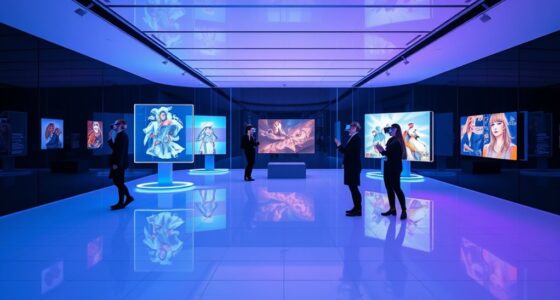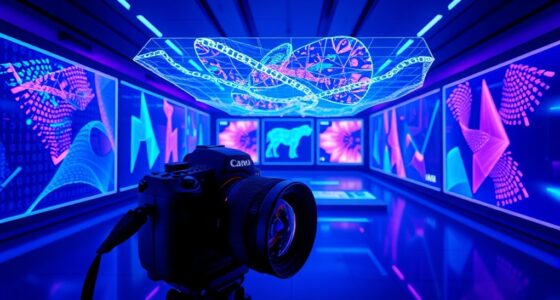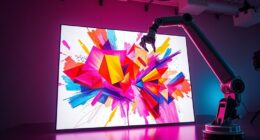Virtual reality is revolutionizing how you experience and create art by immersing you in 3D environments that blend technology, perception, and creativity. From early panoramic paintings and optical illusions to today’s advanced VR and AR tools, the art world has evolved rapidly. These immersive experiences open new avenues for artistic expression, engagement, and accessibility. If you explore further, you’ll uncover how these innovations continue to shape the future of art in the digital age.
Key Takeaways
- Virtual Reality enables immersive, interactive artistic experiences that transcend traditional formats, fostering global collaboration and audience engagement.
- Historical immersive art forms like panoramas and optical illusions laid the groundwork for modern VR artistic innovations.
- Advances in AI and human-computer interaction expand creative possibilities, allowing artists to craft dynamic, sensory-rich virtual environments.
- Virtual galleries and hybrid exhibitions increase accessibility, breaking physical barriers and reaching diverse audiences worldwide.
- The rapidly growing digital and VR art markets offer new opportunities for innovative, multisensory artistic expression and industry expansion.
Historical Foundations of Immersive Art and Virtual Reality

The roots of immersive art and virtual reality trace back to innovations in visual perception and entertainment from the 19th century onward. You can see this in panoramic paintings that aimed to surround viewers with 360-degree scenes, transporting you to distant lands or historical events. Stereoscopic photos, like Charles Wheatstone’s 1838 discovery, gave you a sense of depth through dual images, laying groundwork for 3D perception. Artists during the Renaissance, such as Masaccio, used linear perspective to create depth illusions, influencing immersive techniques. Panoramas became popular mass entertainment, offering virtual experiences. Additionally, optical illusions and perspective studies contributed to the development of immersive experiences, shaping how you now engage with art through sensory and perceptual manipulation. Optical devices and early projection technology further advanced these efforts, enabling more convincing and engaging illusions that laid the foundation for contemporary virtual reality environments. The development of visual perception research played a crucial role in understanding how humans interpret immersive stimuli, leading to more sophisticated virtual art experiences. Furthermore, innovations in sensory engagement techniques have continued to evolve, enhancing the realism and emotional impact of immersive art today. Advances in human-computer interaction have also played a key role in creating more intuitive and immersive virtual environments. Moreover, ongoing research in neuroscience helps refine how immersive art can influence emotions and cognition. These interdisciplinary approaches continue to push the boundaries of what is possible in immersive art and digital experiences.
Technological Breakthroughs Shaping Digital Artistic Expression

Technological breakthroughs like AI, virtual reality (VR), and augmented reality (AR) are revolutionizing how you create and experience digital art. AI algorithms analyze vast datasets to generate unique artworks, challenging traditional ideas of creativity. Artists like Refik Anadol and Mario Klingemann push boundaries with AI-generated pieces that spark intellectual engagement. AI also enhances curation by spotting trends, predicting market shifts, and tailoring recommendations. It fosters collaboration between humans and machines, expanding creative possibilities. VR and AR technologies further transform interaction; VR immerses you in fully 3D environments, while AR overlays virtual elements onto real-world settings, making experiences more engaging. Ethical hacking principles are increasingly relevant in protecting digital art platforms from cyber threats, ensuring creators’ works and transactions remain secure. Biodiversity initiatives are also being integrated into art markets, providing secure and transparent transaction methods. Additionally, immersive technologies can incorporate concepts of digital conservation, promoting awareness and sustainable practices through artistic expression. Incorporating legal expertise into digital art platforms can help navigate complex intellectual property issues and protect artists’ rights. The integration of antioxidants and other health-related concepts into art can also inspire innovative health awareness campaigns. Combined, these breakthroughs enable new forms of expression, breaking physical limits and inviting you into dynamic, multisensory digital art worlds.
Pioneers and Projects Driving VR Art Innovation
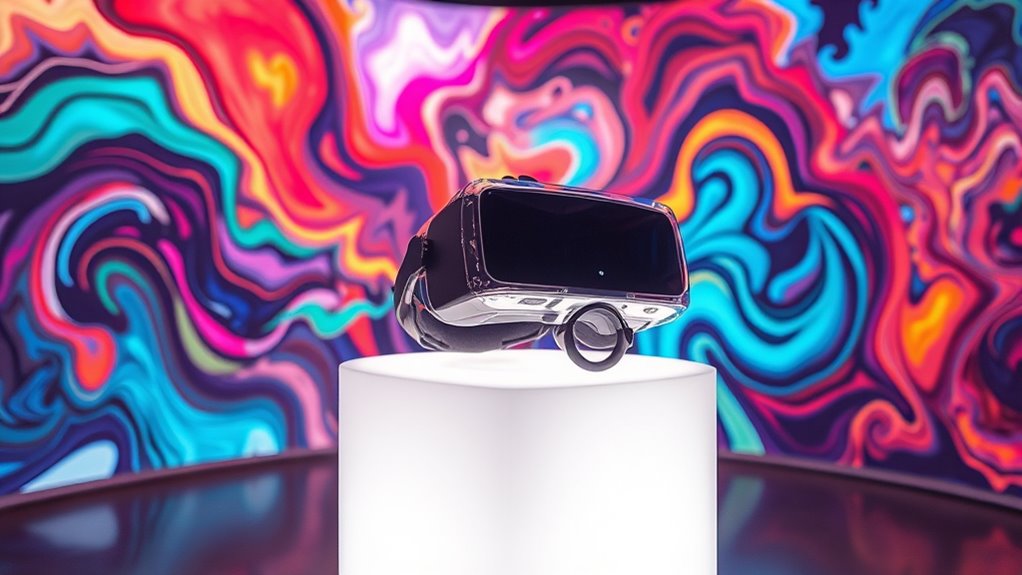
Have you ever wondered how early pioneers shaped the landscape of VR art? These visionaries laid the groundwork for immersive digital experiences. Morton Heilig’s Sensorama, from 1962, offered multisensory stimulation with visuals, sound, wind, and aroma. Myron Krueger’s VIDEOPLACE created interactive environments without headsets, pushing boundaries. Char Davies advanced bio-feedback VR, exploring physiological responses. Here’s a quick overview:
| Pioneer | Key Project | Innovation |
|---|---|---|
| Morton Heilig | Sensorama | Multisensory arcade experience |
| Myron Krueger | VIDEOPLACE | Interactive, goggles-free VR |
| Char Davies | Bio-feedback installations | Physiological feedback |
These projects continue to influence VR art, inspiring new ways to engage and create. Furthermore, the evolution of VR technology from early prototypes to today’s immersive platforms demonstrates the ongoing commitment of innovators to expand artistic expression in the digital age. This continual evolution highlights the importance of VR technology development and immersive experiences in shaping future artistic endeavors and fostering digital art innovation.
The Role of VR in Transforming Artistic Practices and Spaces
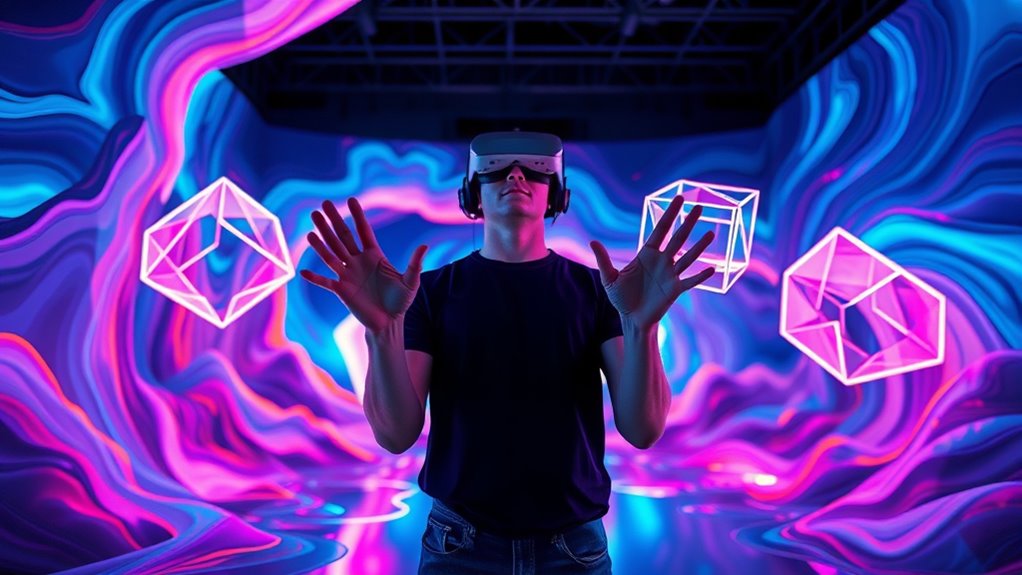
Virtual reality is revolutionizing how artists push creative boundaries, enabling the design of immersive, interactive environments that go beyond traditional formats. It also transforms exhibition spaces, making art accessible globally through virtual galleries and 360-degree experiences. By fostering direct engagement, VR allows you to experience art in new, participatory ways that deepen emotional connection and understanding. Incorporating tuning techniques can further enhance the realism and interactivity of virtual art environments, creating more dynamic and engaging experiences. Additionally, understanding Juice Packaging and Storage can inspire innovative ways to present digital art in a manner that emphasizes freshness and preservation of the viewer’s experience. Recognizing the symbolism within virtual art can enrich viewers’ interpretation and emotional response to immersive works. Moreover, employing effective privacy management strategies helps safeguard personal data when navigating online virtual art spaces, ensuring a secure experience for users. Considering asset division laws and strategies can also be useful when collaborating with other creators or managing shared digital assets in the virtual realm.
Redefining Creative Boundaries
By reshaping how artists and audiences interact, VR is fundamentally transforming creative boundaries. You can now experience dynamic, real-time interactions with digital art installations, engaging with virtual environments in ways that go beyond traditional viewing. Artists manipulate these environments, allowing you to influence narratives and explore sensory dimensions like touch, sound, and spatial awareness. This technological innovation fosters deeper emotional connections and personalization. VR also pushes the limits of artistic expression, enabling immersive, three-dimensional works that blur the lines between painting, sculpture, and performance. You can participate in collaborative projects across the globe or witness ephemeral, evolving art pieces that challenge physical gallery constraints. The rapid growth of immersive technology underscores the increasing significance of VR technology in artistic practices. The integration of digital art into immersive environments is transforming how audiences connect with creative works, with interactive environments playing a central role in this evolution. Moreover, the ability to control virtual experiences offers artists new tools for experimentation and audience engagement, further expanding the creative possibilities.
Expanding Exhibition Spaces
VR is revolutionizing how art is displayed and experienced by breaking down physical boundaries that once confined exhibitions to specific locations. You can now access gallery-quality works anywhere globally, without leaving your home. Virtual environments allow for limitless expansion, accommodating large-scale or impossible installations that physical spaces could never host. Many institutions are adopting hybrid models, offering both physical and virtual exhibitions, which broaden audiences and increase visibility. VR also enhances cultural accessibility, bringing art to remote or underserved communities. Curators and artists are reimagining spaces, creating surreal, non-Euclidean, or fantastical virtual worlds that challenge traditional notions of display. This expansion transforms how audiences engage with art, making exhibitions more versatile, inclusive, and boundaryless than ever before.
Fostering Interactive Engagement
Interactive engagement has become a transformative aspect of contemporary art experiences, drawing audiences deeper into the creative process. With digital and VR exhibitions, you’re more likely to feel a personal connection, as 85% of visitors report a stronger bond with the artwork. VR enhances this by offering immersive environments that invite active participation. It also makes art more accessible, reaching broader audiences beyond traditional gallery spaces. The growing VR market, expected to hit $62.1 billion by 2027, reflects increasing demand for these interactive experiences. Artists now use VR to craft dynamic, immersive worlds that challenge perceptions and foster emotional responses. This shift encourages public involvement, making art more memorable, emotionally impactful, and engaging—transforming how you experience and connect with creative practices.
Current Trends and Market Dynamics in Digital Art Environments
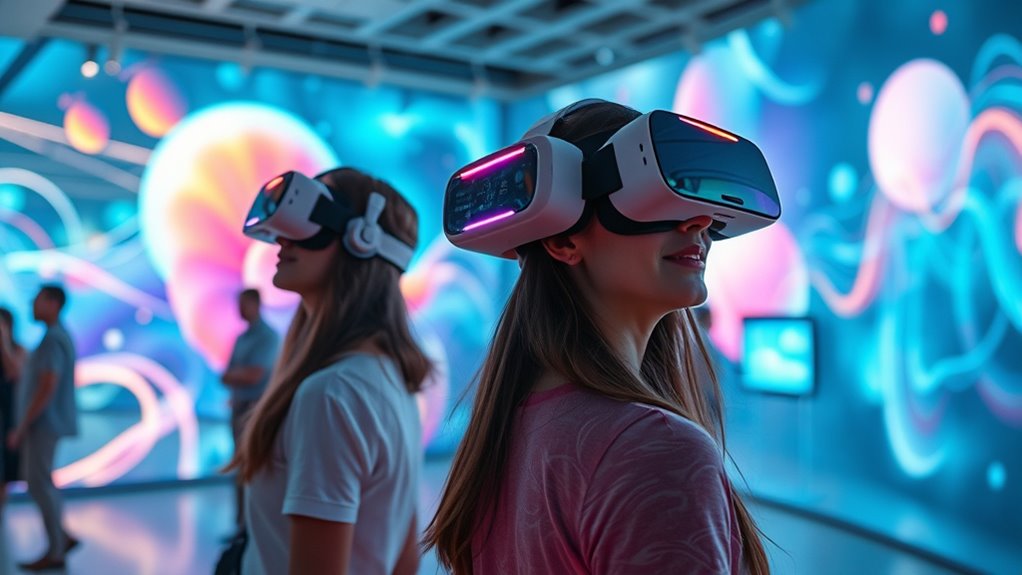
You’re witnessing a rapid expansion in digital art environments, with the market projected to grow from USD 5.8 billion in 2025 to over USD 17.7 billion by 2032. Institutions are increasingly adopting VR and AR to showcase collections, while artists leverage these technologies to create immersive experiences. As private sales and online platforms gain traction, market dynamics are shifting toward more flexible, global, and innovative avenues for art engagement.
Market Growth Trajectories
The digital art market is experiencing rapid growth driven by advances in immersive technologies and increasing adoption across multiple industries. By 2025, the market is valued at around $5.8 billion and is projected to hit $17.72 billion by 2032, growing at a 17.3% CAGR. Globally, digital art could reach $30.69 billion by 2035, expanding steadily at 15.53%. Meanwhile, the VR market is booming, expected to grow from $43.58 billion in 2024 to nearly $383 billion in 2033, with a 27.31% CAGR. The 3D virtual art space market is also rising, from $1.18 billion in 2024 to $3.54 billion by 2033. These trajectories highlight a vibrant, expanding landscape driven by technological advancements and increasing cross-industry integration.
Adoption by Institutions
Despite growing interest among students and institutions, widespread adoption of VR technology in educational and art environments remains limited. Only 23% of schools have tested VR, and just 10% plan to expand its use. Higher education institutions lead in adoption, with 67% reporting moderate to extensive XR use, often investing heavily—over half have purchased at least 50 XR headsets. In contrast, further education lags behind, with only 46% showing moderate to extensive use and fewer investments. Younger demographics, especially 16–34-year-olds, drive demand, influencing art programs. However, barriers like high costs, technical complexity, and limited pilot programs hinder broader integration. Growing student interest and successful pilot projects, though, signal potential for increased adoption in the future.
Artist Engagement Trends
Artists are increasingly leveraging digital platforms to expand their reach and sales, with 43% of galleries planning to prioritize online sales to make art more accessible worldwide. You’ll notice digital art’s popularity soaring, with the market valued at $5.8 billion in 2025 and projected to reach $17.72 billion by 2032. Young collectors now prefer online platforms for their diversity and accessibility, broadening your potential audience. You can tap into immersive 3D art and hybrid aesthetics, blending handcrafted and digital elements to create unique experiences. Digitalization allows you to reach a global audience, overcoming geographic barriers. As the market grows, driven by AI, AR/VR, and NFTs, your engagement in digital art environments becomes crucial for expanding visibility, sales, and cultural relevance in the evolving art scene.
Future Directions and Opportunities in Virtual Reality Art
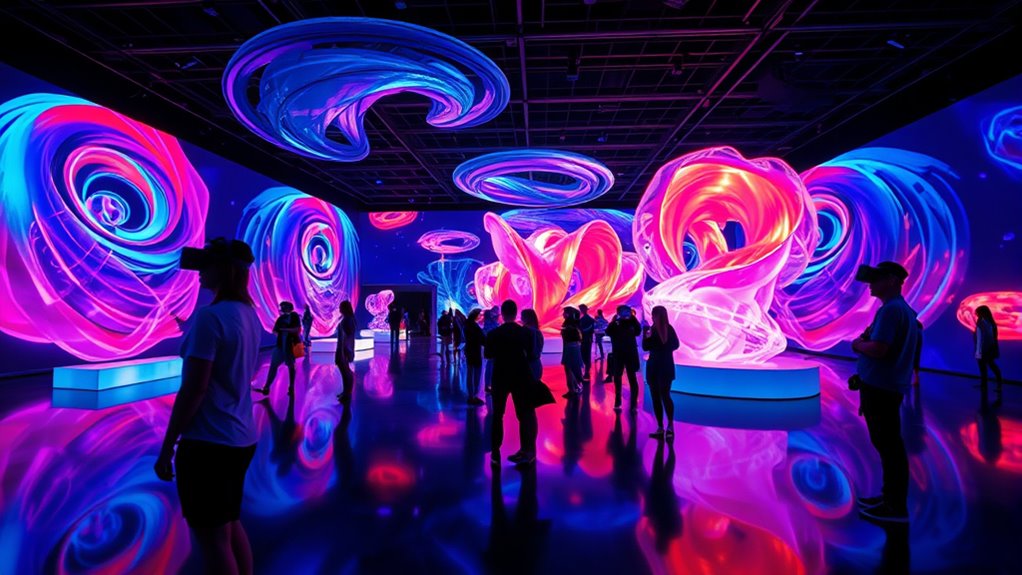
Future directions in virtual reality art are driven by the integration of Cross-Reality (XR) technologies, which enable seamless switching between VR, AR, and MR experiences. You’ll be able to move fluidly between virtual meetings, AR navigation, and MR 3D model reviews within a single workflow. Hardware and platforms are evolving to support multiple reality modes natively, while cloud streaming makes high-performance VR tools accessible without costly upgrades. Advances in multisensory feedback—touch, smell, taste—will deepen immersion, making experiences more emotionally impactful. Improved 3D capture techniques, like photogrammetry and AI-driven modeling, will increase realism and authenticity. Social and collaborative VR platforms will expand, fostering inclusive, shared artistic experiences. As the market grows, so will opportunities for artists, developers, and businesses to innovate and monetize immersive VR art.
Frequently Asked Questions
How Does VR Influence Audience Engagement in Contemporary Art Exhibitions?
You’ll find that VR notably boosts your engagement in contemporary art exhibitions. It transforms passive viewing into active participation, letting you explore artworks in 3D, examine details up close, and even experience immersive environments. This interactive approach makes your visit more memorable and enjoyable, encouraging repeated exploration. VR also broadens accessibility, allowing you to experience art remotely, regardless of physical limitations, and creates a stronger personal connection with the pieces.
What Are the Ethical Considerations in Creating Immersive VR Art Experiences?
You need to take into account several ethical issues when creating immersive VR art experiences. Be mindful of sensitive content that might desensitize or harm users, and ensure age-appropriate warnings to protect vulnerable groups. Protect users’ privacy through transparent data policies and obtain informed consent. Also, design content culturally sensitively, promote inclusivity, and stay aware of legal regulations. Balancing innovation with responsibility ensures the experience remains respectful and trustworthy.
How Accessible Are VR Tools for Emerging Artists and Diverse Communities?
You might find VR tools becoming more accessible, especially with lower-cost headsets and smartphone options that broaden opportunities. However, costs, technical skills, and internet access still pose challenges, limiting some artists and communities. While community resources and platforms promote inclusivity, disparities remain, especially for underrepresented groups or those in rural areas. Overall, progress is steady, but full accessibility for all artists and diverse communities isn’t yet achieved.
In What Ways Can VR Help Preserve and Restore Endangered Artworks?
You can use VR to preserve and restore endangered artworks by creating detailed digital models that capture their current state. VR allows you to simulate restoration techniques before applying them, minimizing risks. It also helps document artworks in their original environment, making them accessible for future study. Additionally, VR enables you to reconstruct lost or damaged pieces, ensuring their cultural significance endures despite physical deterioration.
What Challenges Exist in Integrating VR Into Traditional Art Education Curricula?
You face a mix of challenges when integrating VR into traditional art education. While VR offers innovative ways to engage students and access remote artworks, it also brings technical hurdles like high equipment costs, space needs, and complex setups. Pedagogically, balancing immersive experiences with curriculum goals and ensuring accessibility can be tough. Plus, training teachers and managing psychological impacts require ongoing effort, making seamless integration a real challenge.
Conclusion
As you explore the evolving landscape of virtual reality and art, remember that every immersive experience hints at new horizons yet to be fully understood. While the digital domain offers endless possibilities, it gently reminds us that true innovation often requires patience and openness. Embrace these shifting paradigms, knowing that the most meaningful creations may come when you’re willing to navigate the delicate balance between technology and human connection.




